
"Late Afternoon in the Late Triassic", 1991, 14’ x 29’, oil on masonite; Image courtesy of Dinosaur State Park and Arboretum.

"Late Afternoon in the Late Triassic", 1991, 14’ x 29’, oil on masonite; Image courtesy of Dinosaur State Park and Arboretum.
It is the end of a day in the Late Triassic. We look south/southwest down the rift valley formed by the Eastern Border Fault. Beyond the horizon lies another rift valley, gigantic in size, slowly broadening and creating a home for a new ocean, the Atlantic.
The active fault runs along the base of the mountains. The land to the east of the fault is rising, the ground we stand on is dropping. Monsoon rains attack the rising block of land carving deep canyons. The rock, sand and gravel weathered from the highlands are swept out of the canyons and deposited, forming great wedges of sediments called alluvial fans. The water draining off the mountains accumulates into a braided river that flows to the south and west. As the basin floor drops sediment is carried in. Everything we see in the valley will become buried under thousands of feet of sediment.
The flora and fauna of the Late Triassic were remarkably diverse. Though numerous orders of reptiles were present, many failed to survive the coming Triassic-Jurassic extinction, which occurred about 201 million years ago and killed off around 75% of existing species. One notable survivor of the extinction were dinosaurs. The diversifying flora of the late Triassic, however, went on to dominate the terrestrial ecosystems of the Jurassic, and some types of Triassic plants, such as gingko trees, are still with us today.